Mathematics Curriculum Unit Analysis and Diverse Learner Strategies
VerifiedAdded on 2021/02/19
|8
|2464
|97
Report
AI Summary
This report provides an in-depth analysis of the 'Australian Curriculum: Mathematics', focusing on pedagogical strategies employed by primary school teachers for students aged 4, 5, and 6. It examines the achievement standards within the curriculum, outlining what students are expected to learn at each age level, and identifies various pedagogical strategies, including problem-based learning and fostering a positive attitude towards mathematics. The report further explores strategies for diverse learners, such as those with learning difficulties, and discusses the effectiveness of different approaches in catering to varied learning styles. It highlights the challenges and limitations associated with specific strategies while emphasizing the importance of creating effective assessment tasks that evaluate key content and learning outcomes. The conclusion reiterates the significance of tailoring pedagogical methods to meet the diverse needs of students and the importance of creating assessment tasks that reflect a comprehensive understanding of the subject matter. The report also provides the references of the books and journals used for the analysis.
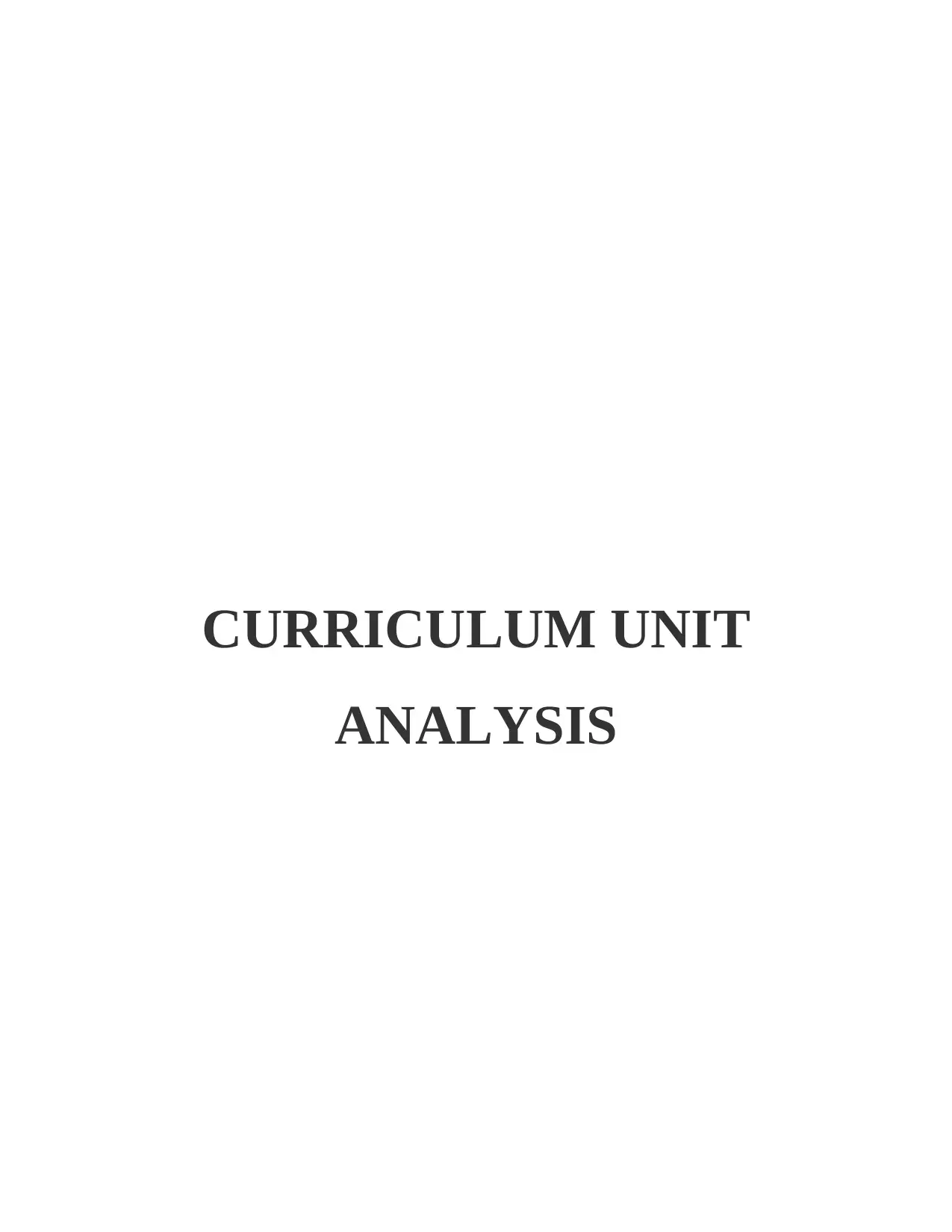
CURRICULUM UNIT
ANALYSIS
ANALYSIS
Paraphrase This Document
Need a fresh take? Get an instant paraphrase of this document with our AI Paraphraser
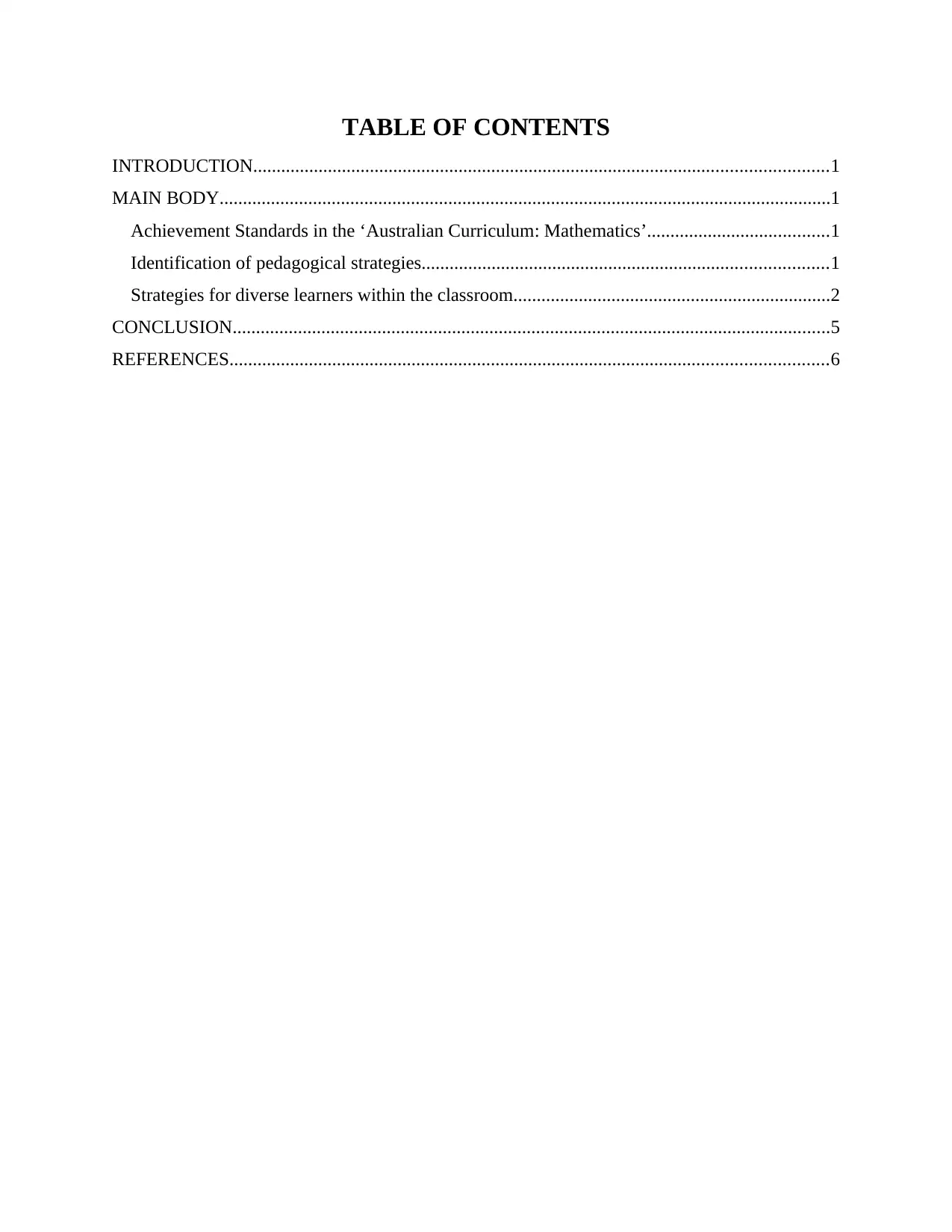
TABLE OF CONTENTS
INTRODUCTION...........................................................................................................................1
MAIN BODY...................................................................................................................................1
Achievement Standards in the ‘Australian Curriculum: Mathematics’.......................................1
Identification of pedagogical strategies.......................................................................................1
Strategies for diverse learners within the classroom....................................................................2
CONCLUSION................................................................................................................................5
REFERENCES................................................................................................................................6
INTRODUCTION...........................................................................................................................1
MAIN BODY...................................................................................................................................1
Achievement Standards in the ‘Australian Curriculum: Mathematics’.......................................1
Identification of pedagogical strategies.......................................................................................1
Strategies for diverse learners within the classroom....................................................................2
CONCLUSION................................................................................................................................5
REFERENCES................................................................................................................................6
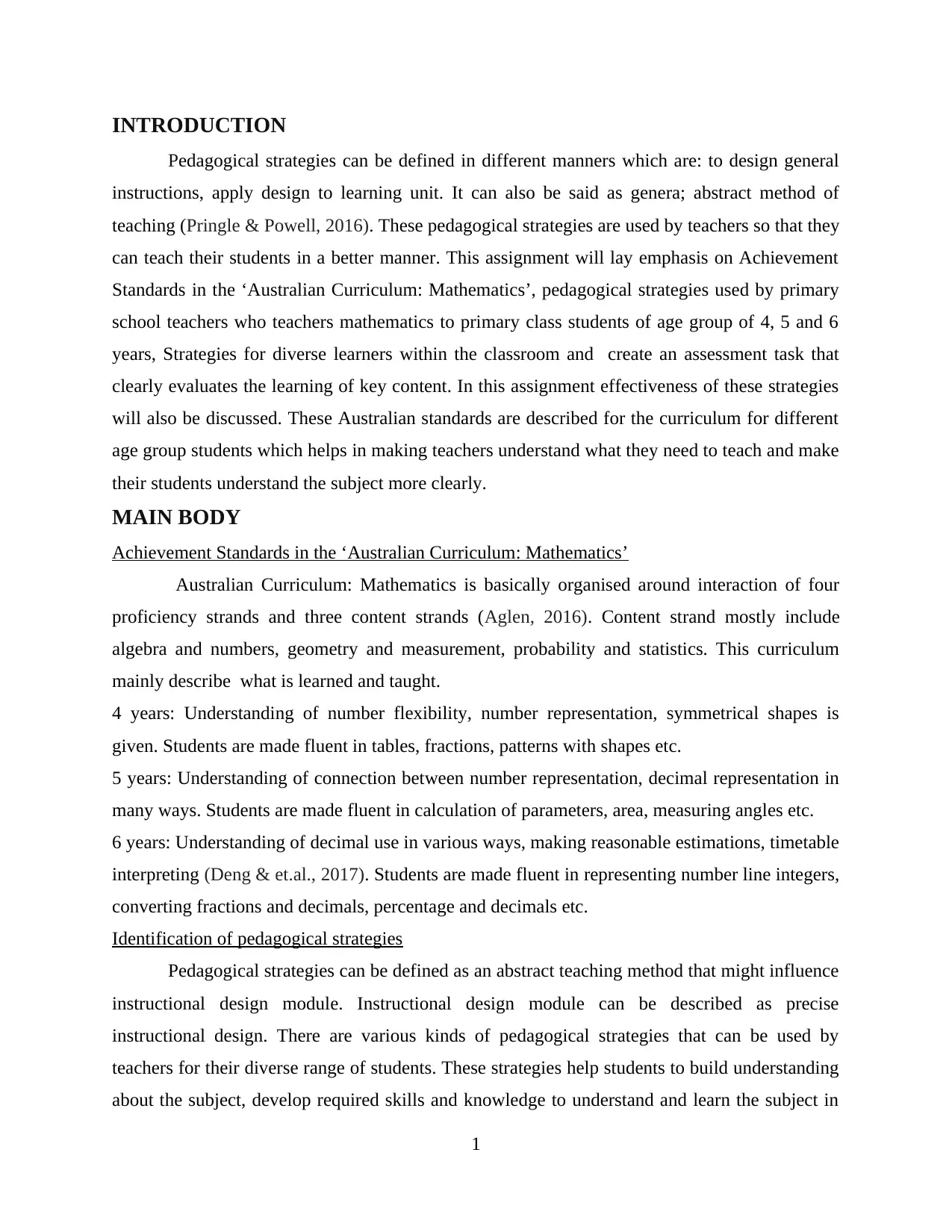
INTRODUCTION
Pedagogical strategies can be defined in different manners which are: to design general
instructions, apply design to learning unit. It can also be said as genera; abstract method of
teaching (Pringle & Powell, 2016). These pedagogical strategies are used by teachers so that they
can teach their students in a better manner. This assignment will lay emphasis on Achievement
Standards in the ‘Australian Curriculum: Mathematics’, pedagogical strategies used by primary
school teachers who teachers mathematics to primary class students of age group of 4, 5 and 6
years, Strategies for diverse learners within the classroom and create an assessment task that
clearly evaluates the learning of key content. In this assignment effectiveness of these strategies
will also be discussed. These Australian standards are described for the curriculum for different
age group students which helps in making teachers understand what they need to teach and make
their students understand the subject more clearly.
MAIN BODY
Achievement Standards in the ‘Australian Curriculum: Mathematics’
Australian Curriculum: Mathematics is basically organised around interaction of four
proficiency strands and three content strands (Aglen, 2016). Content strand mostly include
algebra and numbers, geometry and measurement, probability and statistics. This curriculum
mainly describe what is learned and taught.
4 years: Understanding of number flexibility, number representation, symmetrical shapes is
given. Students are made fluent in tables, fractions, patterns with shapes etc.
5 years: Understanding of connection between number representation, decimal representation in
many ways. Students are made fluent in calculation of parameters, area, measuring angles etc.
6 years: Understanding of decimal use in various ways, making reasonable estimations, timetable
interpreting (Deng & et.al., 2017). Students are made fluent in representing number line integers,
converting fractions and decimals, percentage and decimals etc.
Identification of pedagogical strategies
Pedagogical strategies can be defined as an abstract teaching method that might influence
instructional design module. Instructional design module can be described as precise
instructional design. There are various kinds of pedagogical strategies that can be used by
teachers for their diverse range of students. These strategies help students to build understanding
about the subject, develop required skills and knowledge to understand and learn the subject in
1
Pedagogical strategies can be defined in different manners which are: to design general
instructions, apply design to learning unit. It can also be said as genera; abstract method of
teaching (Pringle & Powell, 2016). These pedagogical strategies are used by teachers so that they
can teach their students in a better manner. This assignment will lay emphasis on Achievement
Standards in the ‘Australian Curriculum: Mathematics’, pedagogical strategies used by primary
school teachers who teachers mathematics to primary class students of age group of 4, 5 and 6
years, Strategies for diverse learners within the classroom and create an assessment task that
clearly evaluates the learning of key content. In this assignment effectiveness of these strategies
will also be discussed. These Australian standards are described for the curriculum for different
age group students which helps in making teachers understand what they need to teach and make
their students understand the subject more clearly.
MAIN BODY
Achievement Standards in the ‘Australian Curriculum: Mathematics’
Australian Curriculum: Mathematics is basically organised around interaction of four
proficiency strands and three content strands (Aglen, 2016). Content strand mostly include
algebra and numbers, geometry and measurement, probability and statistics. This curriculum
mainly describe what is learned and taught.
4 years: Understanding of number flexibility, number representation, symmetrical shapes is
given. Students are made fluent in tables, fractions, patterns with shapes etc.
5 years: Understanding of connection between number representation, decimal representation in
many ways. Students are made fluent in calculation of parameters, area, measuring angles etc.
6 years: Understanding of decimal use in various ways, making reasonable estimations, timetable
interpreting (Deng & et.al., 2017). Students are made fluent in representing number line integers,
converting fractions and decimals, percentage and decimals etc.
Identification of pedagogical strategies
Pedagogical strategies can be defined as an abstract teaching method that might influence
instructional design module. Instructional design module can be described as precise
instructional design. There are various kinds of pedagogical strategies that can be used by
teachers for their diverse range of students. These strategies help students to build understanding
about the subject, develop required skills and knowledge to understand and learn the subject in
1
You're viewing a preview
Unlock full access by subscribing today!
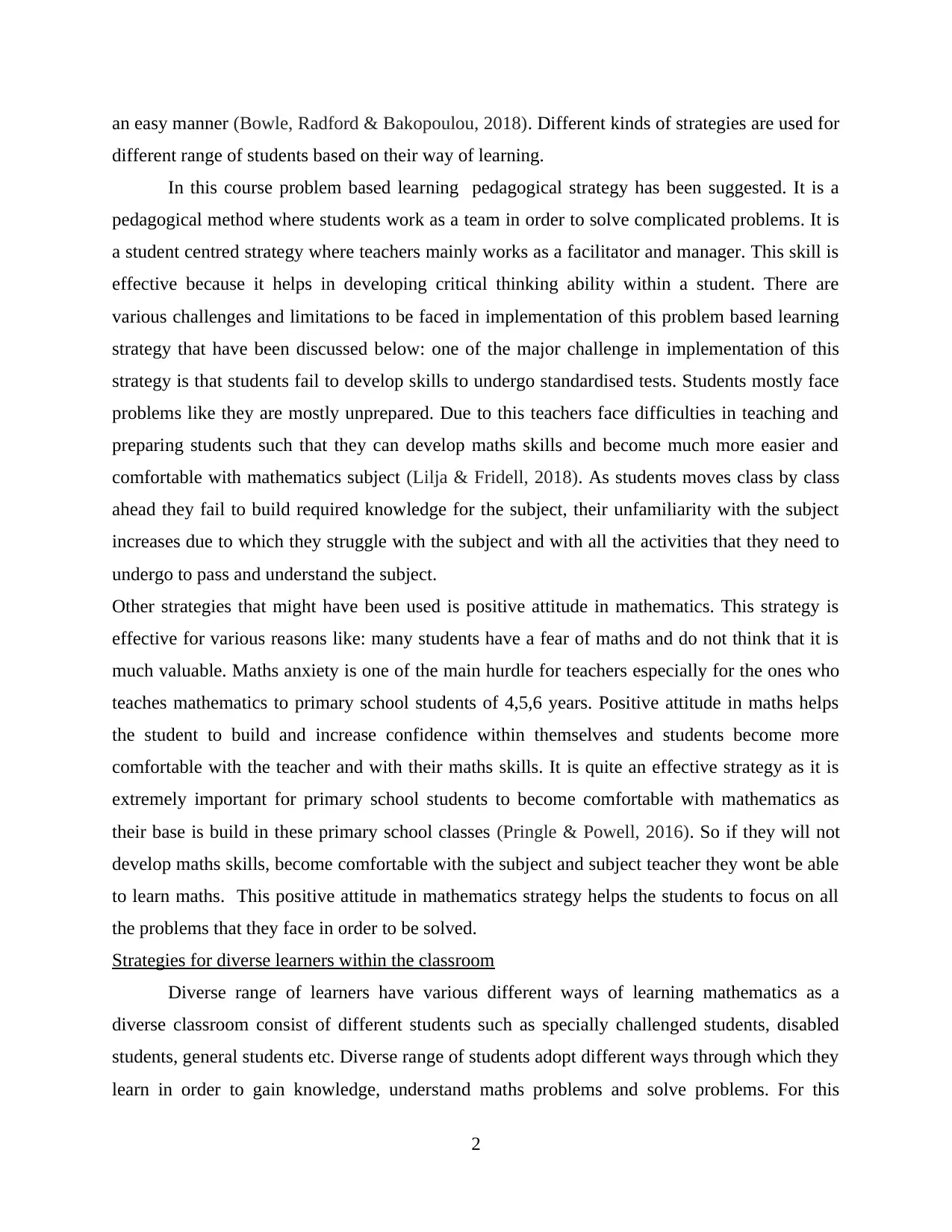
an easy manner (Bowle, Radford & Bakopoulou, 2018). Different kinds of strategies are used for
different range of students based on their way of learning.
In this course problem based learning pedagogical strategy has been suggested. It is a
pedagogical method where students work as a team in order to solve complicated problems. It is
a student centred strategy where teachers mainly works as a facilitator and manager. This skill is
effective because it helps in developing critical thinking ability within a student. There are
various challenges and limitations to be faced in implementation of this problem based learning
strategy that have been discussed below: one of the major challenge in implementation of this
strategy is that students fail to develop skills to undergo standardised tests. Students mostly face
problems like they are mostly unprepared. Due to this teachers face difficulties in teaching and
preparing students such that they can develop maths skills and become much more easier and
comfortable with mathematics subject (Lilja & Fridell, 2018). As students moves class by class
ahead they fail to build required knowledge for the subject, their unfamiliarity with the subject
increases due to which they struggle with the subject and with all the activities that they need to
undergo to pass and understand the subject.
Other strategies that might have been used is positive attitude in mathematics. This strategy is
effective for various reasons like: many students have a fear of maths and do not think that it is
much valuable. Maths anxiety is one of the main hurdle for teachers especially for the ones who
teaches mathematics to primary school students of 4,5,6 years. Positive attitude in maths helps
the student to build and increase confidence within themselves and students become more
comfortable with the teacher and with their maths skills. It is quite an effective strategy as it is
extremely important for primary school students to become comfortable with mathematics as
their base is build in these primary school classes (Pringle & Powell, 2016). So if they will not
develop maths skills, become comfortable with the subject and subject teacher they wont be able
to learn maths. This positive attitude in mathematics strategy helps the students to focus on all
the problems that they face in order to be solved.
Strategies for diverse learners within the classroom
Diverse range of learners have various different ways of learning mathematics as a
diverse classroom consist of different students such as specially challenged students, disabled
students, general students etc. Diverse range of students adopt different ways through which they
learn in order to gain knowledge, understand maths problems and solve problems. For this
2
different range of students based on their way of learning.
In this course problem based learning pedagogical strategy has been suggested. It is a
pedagogical method where students work as a team in order to solve complicated problems. It is
a student centred strategy where teachers mainly works as a facilitator and manager. This skill is
effective because it helps in developing critical thinking ability within a student. There are
various challenges and limitations to be faced in implementation of this problem based learning
strategy that have been discussed below: one of the major challenge in implementation of this
strategy is that students fail to develop skills to undergo standardised tests. Students mostly face
problems like they are mostly unprepared. Due to this teachers face difficulties in teaching and
preparing students such that they can develop maths skills and become much more easier and
comfortable with mathematics subject (Lilja & Fridell, 2018). As students moves class by class
ahead they fail to build required knowledge for the subject, their unfamiliarity with the subject
increases due to which they struggle with the subject and with all the activities that they need to
undergo to pass and understand the subject.
Other strategies that might have been used is positive attitude in mathematics. This strategy is
effective for various reasons like: many students have a fear of maths and do not think that it is
much valuable. Maths anxiety is one of the main hurdle for teachers especially for the ones who
teaches mathematics to primary school students of 4,5,6 years. Positive attitude in maths helps
the student to build and increase confidence within themselves and students become more
comfortable with the teacher and with their maths skills. It is quite an effective strategy as it is
extremely important for primary school students to become comfortable with mathematics as
their base is build in these primary school classes (Pringle & Powell, 2016). So if they will not
develop maths skills, become comfortable with the subject and subject teacher they wont be able
to learn maths. This positive attitude in mathematics strategy helps the students to focus on all
the problems that they face in order to be solved.
Strategies for diverse learners within the classroom
Diverse range of learners have various different ways of learning mathematics as a
diverse classroom consist of different students such as specially challenged students, disabled
students, general students etc. Diverse range of students adopt different ways through which they
learn in order to gain knowledge, understand maths problems and solve problems. For this
2
Paraphrase This Document
Need a fresh take? Get an instant paraphrase of this document with our AI Paraphraser
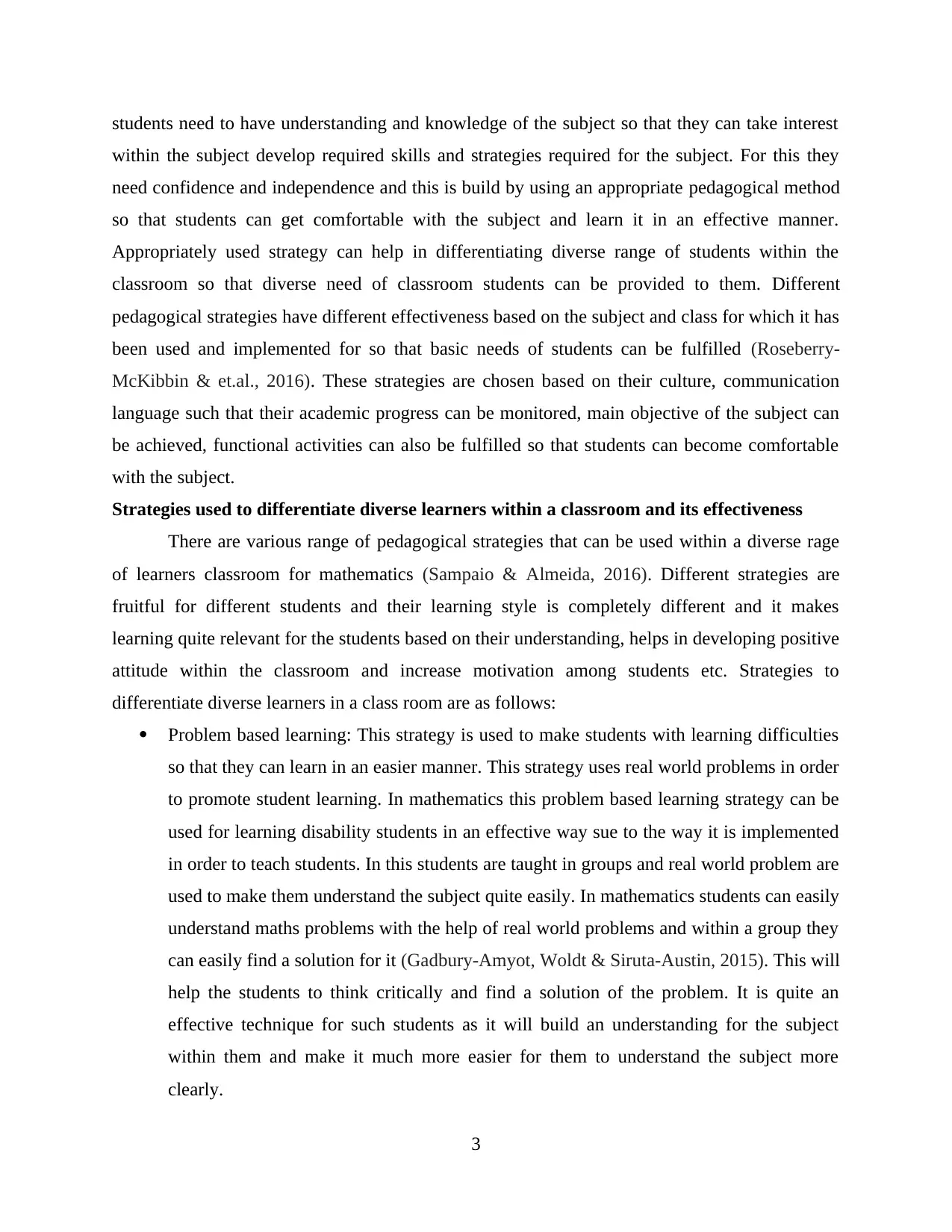
students need to have understanding and knowledge of the subject so that they can take interest
within the subject develop required skills and strategies required for the subject. For this they
need confidence and independence and this is build by using an appropriate pedagogical method
so that students can get comfortable with the subject and learn it in an effective manner.
Appropriately used strategy can help in differentiating diverse range of students within the
classroom so that diverse need of classroom students can be provided to them. Different
pedagogical strategies have different effectiveness based on the subject and class for which it has
been used and implemented for so that basic needs of students can be fulfilled (Roseberry-
McKibbin & et.al., 2016). These strategies are chosen based on their culture, communication
language such that their academic progress can be monitored, main objective of the subject can
be achieved, functional activities can also be fulfilled so that students can become comfortable
with the subject.
Strategies used to differentiate diverse learners within a classroom and its effectiveness
There are various range of pedagogical strategies that can be used within a diverse rage
of learners classroom for mathematics (Sampaio & Almeida, 2016). Different strategies are
fruitful for different students and their learning style is completely different and it makes
learning quite relevant for the students based on their understanding, helps in developing positive
attitude within the classroom and increase motivation among students etc. Strategies to
differentiate diverse learners in a class room are as follows:
Problem based learning: This strategy is used to make students with learning difficulties
so that they can learn in an easier manner. This strategy uses real world problems in order
to promote student learning. In mathematics this problem based learning strategy can be
used for learning disability students in an effective way sue to the way it is implemented
in order to teach students. In this students are taught in groups and real world problem are
used to make them understand the subject quite easily. In mathematics students can easily
understand maths problems with the help of real world problems and within a group they
can easily find a solution for it (Gadbury-Amyot, Woldt & Siruta-Austin, 2015). This will
help the students to think critically and find a solution of the problem. It is quite an
effective technique for such students as it will build an understanding for the subject
within them and make it much more easier for them to understand the subject more
clearly.
3
within the subject develop required skills and strategies required for the subject. For this they
need confidence and independence and this is build by using an appropriate pedagogical method
so that students can get comfortable with the subject and learn it in an effective manner.
Appropriately used strategy can help in differentiating diverse range of students within the
classroom so that diverse need of classroom students can be provided to them. Different
pedagogical strategies have different effectiveness based on the subject and class for which it has
been used and implemented for so that basic needs of students can be fulfilled (Roseberry-
McKibbin & et.al., 2016). These strategies are chosen based on their culture, communication
language such that their academic progress can be monitored, main objective of the subject can
be achieved, functional activities can also be fulfilled so that students can become comfortable
with the subject.
Strategies used to differentiate diverse learners within a classroom and its effectiveness
There are various range of pedagogical strategies that can be used within a diverse rage
of learners classroom for mathematics (Sampaio & Almeida, 2016). Different strategies are
fruitful for different students and their learning style is completely different and it makes
learning quite relevant for the students based on their understanding, helps in developing positive
attitude within the classroom and increase motivation among students etc. Strategies to
differentiate diverse learners in a class room are as follows:
Problem based learning: This strategy is used to make students with learning difficulties
so that they can learn in an easier manner. This strategy uses real world problems in order
to promote student learning. In mathematics this problem based learning strategy can be
used for learning disability students in an effective way sue to the way it is implemented
in order to teach students. In this students are taught in groups and real world problem are
used to make them understand the subject quite easily. In mathematics students can easily
understand maths problems with the help of real world problems and within a group they
can easily find a solution for it (Gadbury-Amyot, Woldt & Siruta-Austin, 2015). This will
help the students to think critically and find a solution of the problem. It is quite an
effective technique for such students as it will build an understanding for the subject
within them and make it much more easier for them to understand the subject more
clearly.
3
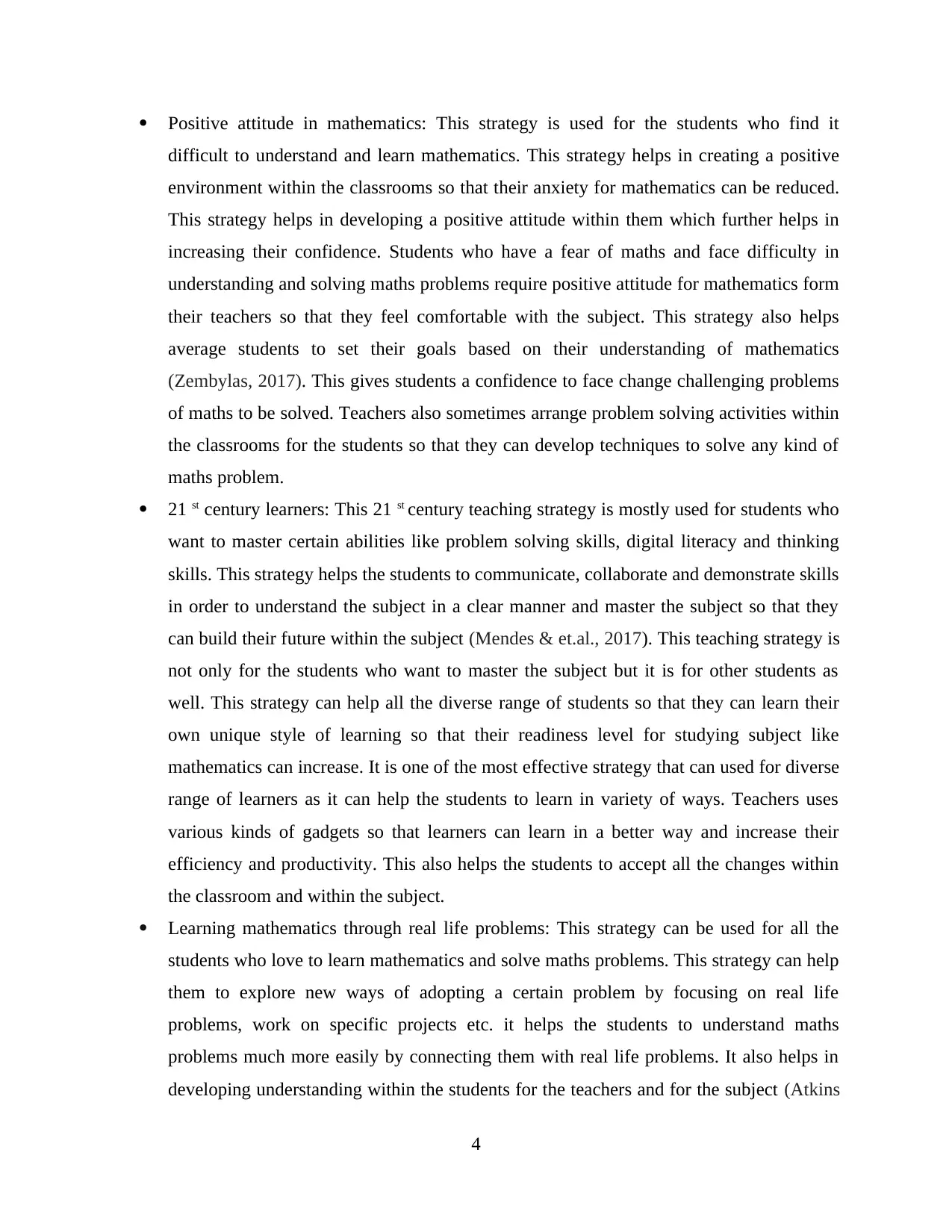
Positive attitude in mathematics: This strategy is used for the students who find it
difficult to understand and learn mathematics. This strategy helps in creating a positive
environment within the classrooms so that their anxiety for mathematics can be reduced.
This strategy helps in developing a positive attitude within them which further helps in
increasing their confidence. Students who have a fear of maths and face difficulty in
understanding and solving maths problems require positive attitude for mathematics form
their teachers so that they feel comfortable with the subject. This strategy also helps
average students to set their goals based on their understanding of mathematics
(Zembylas, 2017). This gives students a confidence to face change challenging problems
of maths to be solved. Teachers also sometimes arrange problem solving activities within
the classrooms for the students so that they can develop techniques to solve any kind of
maths problem.
21 st century learners: This 21 st century teaching strategy is mostly used for students who
want to master certain abilities like problem solving skills, digital literacy and thinking
skills. This strategy helps the students to communicate, collaborate and demonstrate skills
in order to understand the subject in a clear manner and master the subject so that they
can build their future within the subject (Mendes & et.al., 2017). This teaching strategy is
not only for the students who want to master the subject but it is for other students as
well. This strategy can help all the diverse range of students so that they can learn their
own unique style of learning so that their readiness level for studying subject like
mathematics can increase. It is one of the most effective strategy that can used for diverse
range of learners as it can help the students to learn in variety of ways. Teachers uses
various kinds of gadgets so that learners can learn in a better way and increase their
efficiency and productivity. This also helps the students to accept all the changes within
the classroom and within the subject.
Learning mathematics through real life problems: This strategy can be used for all the
students who love to learn mathematics and solve maths problems. This strategy can help
them to explore new ways of adopting a certain problem by focusing on real life
problems, work on specific projects etc. it helps the students to understand maths
problems much more easily by connecting them with real life problems. It also helps in
developing understanding within the students for the teachers and for the subject (Atkins
4
difficult to understand and learn mathematics. This strategy helps in creating a positive
environment within the classrooms so that their anxiety for mathematics can be reduced.
This strategy helps in developing a positive attitude within them which further helps in
increasing their confidence. Students who have a fear of maths and face difficulty in
understanding and solving maths problems require positive attitude for mathematics form
their teachers so that they feel comfortable with the subject. This strategy also helps
average students to set their goals based on their understanding of mathematics
(Zembylas, 2017). This gives students a confidence to face change challenging problems
of maths to be solved. Teachers also sometimes arrange problem solving activities within
the classrooms for the students so that they can develop techniques to solve any kind of
maths problem.
21 st century learners: This 21 st century teaching strategy is mostly used for students who
want to master certain abilities like problem solving skills, digital literacy and thinking
skills. This strategy helps the students to communicate, collaborate and demonstrate skills
in order to understand the subject in a clear manner and master the subject so that they
can build their future within the subject (Mendes & et.al., 2017). This teaching strategy is
not only for the students who want to master the subject but it is for other students as
well. This strategy can help all the diverse range of students so that they can learn their
own unique style of learning so that their readiness level for studying subject like
mathematics can increase. It is one of the most effective strategy that can used for diverse
range of learners as it can help the students to learn in variety of ways. Teachers uses
various kinds of gadgets so that learners can learn in a better way and increase their
efficiency and productivity. This also helps the students to accept all the changes within
the classroom and within the subject.
Learning mathematics through real life problems: This strategy can be used for all the
students who love to learn mathematics and solve maths problems. This strategy can help
them to explore new ways of adopting a certain problem by focusing on real life
problems, work on specific projects etc. it helps the students to understand maths
problems much more easily by connecting them with real life problems. It also helps in
developing understanding within the students for the teachers and for the subject (Atkins
4
You're viewing a preview
Unlock full access by subscribing today!
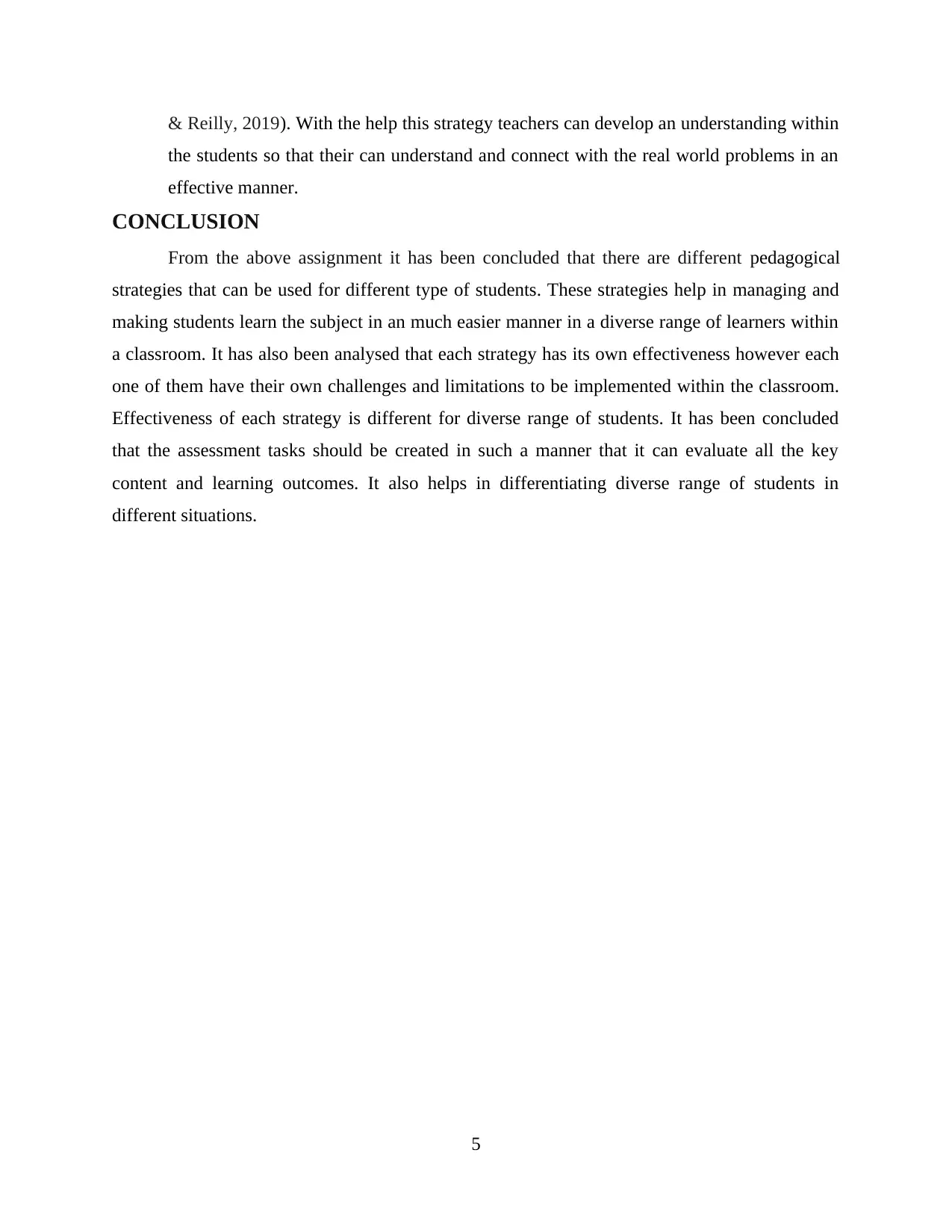
& Reilly, 2019). With the help this strategy teachers can develop an understanding within
the students so that their can understand and connect with the real world problems in an
effective manner.
CONCLUSION
From the above assignment it has been concluded that there are different pedagogical
strategies that can be used for different type of students. These strategies help in managing and
making students learn the subject in an much easier manner in a diverse range of learners within
a classroom. It has also been analysed that each strategy has its own effectiveness however each
one of them have their own challenges and limitations to be implemented within the classroom.
Effectiveness of each strategy is different for diverse range of students. It has been concluded
that the assessment tasks should be created in such a manner that it can evaluate all the key
content and learning outcomes. It also helps in differentiating diverse range of students in
different situations.
5
the students so that their can understand and connect with the real world problems in an
effective manner.
CONCLUSION
From the above assignment it has been concluded that there are different pedagogical
strategies that can be used for different type of students. These strategies help in managing and
making students learn the subject in an much easier manner in a diverse range of learners within
a classroom. It has also been analysed that each strategy has its own effectiveness however each
one of them have their own challenges and limitations to be implemented within the classroom.
Effectiveness of each strategy is different for diverse range of students. It has been concluded
that the assessment tasks should be created in such a manner that it can evaluate all the key
content and learning outcomes. It also helps in differentiating diverse range of students in
different situations.
5
Paraphrase This Document
Need a fresh take? Get an instant paraphrase of this document with our AI Paraphraser
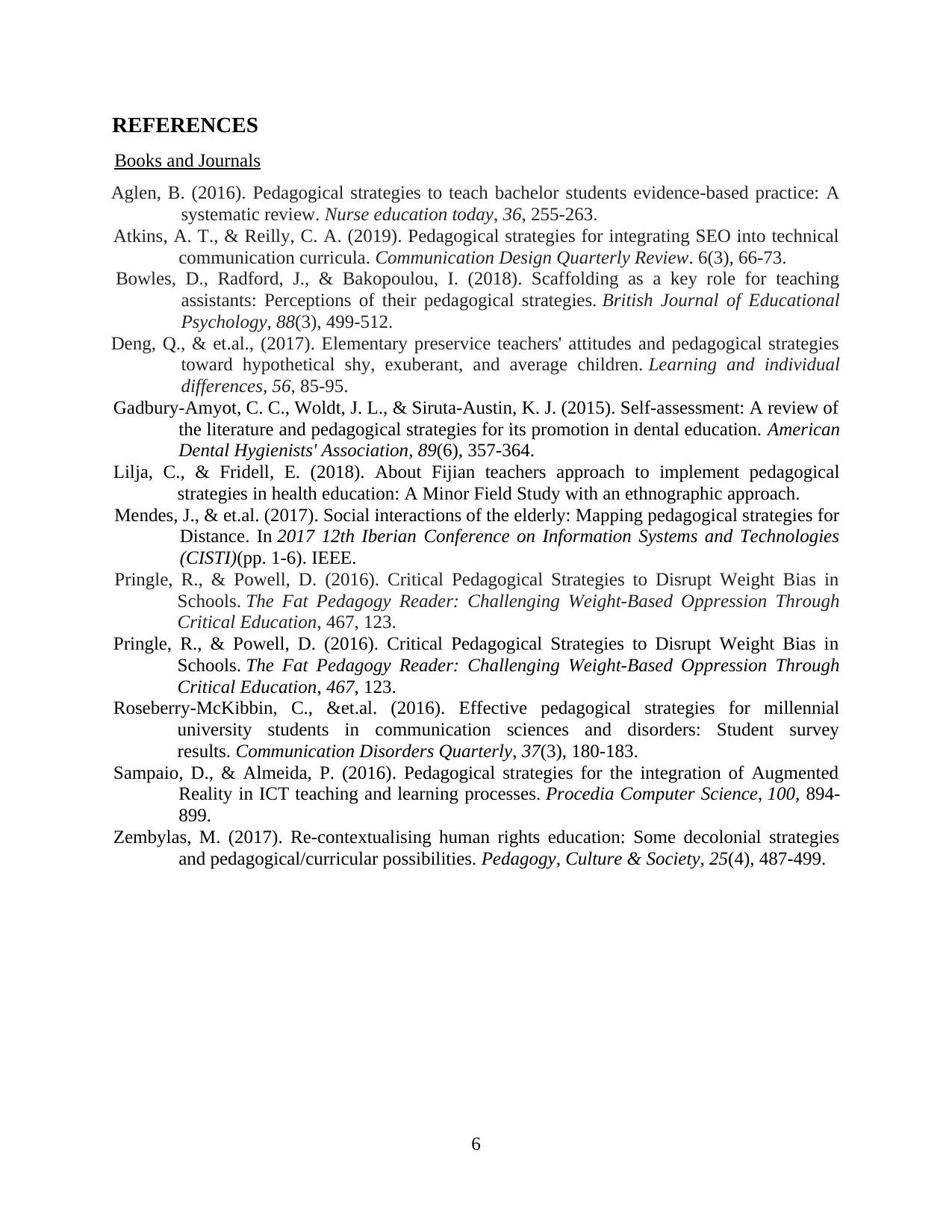
REFERENCES
Books and Journals
Aglen, B. (2016). Pedagogical strategies to teach bachelor students evidence-based practice: A
systematic review. Nurse education today, 36, 255-263.
Atkins, A. T., & Reilly, C. A. (2019). Pedagogical strategies for integrating SEO into technical
communication curricula. Communication Design Quarterly Review. 6(3), 66-73.
Bowles, D., Radford, J., & Bakopoulou, I. (2018). Scaffolding as a key role for teaching
assistants: Perceptions of their pedagogical strategies. British Journal of Educational
Psychology, 88(3), 499-512.
Deng, Q., & et.al., (2017). Elementary preservice teachers' attitudes and pedagogical strategies
toward hypothetical shy, exuberant, and average children. Learning and individual
differences, 56, 85-95.
Gadbury-Amyot, C. C., Woldt, J. L., & Siruta-Austin, K. J. (2015). Self-assessment: A review of
the literature and pedagogical strategies for its promotion in dental education. American
Dental Hygienists' Association, 89(6), 357-364.
Lilja, C., & Fridell, E. (2018). About Fijian teachers approach to implement pedagogical
strategies in health education: A Minor Field Study with an ethnographic approach.
Mendes, J., & et.al. (2017). Social interactions of the elderly: Mapping pedagogical strategies for
Distance. In 2017 12th Iberian Conference on Information Systems and Technologies
(CISTI)(pp. 1-6). IEEE.
Pringle, R., & Powell, D. (2016). Critical Pedagogical Strategies to Disrupt Weight Bias in
Schools. The Fat Pedagogy Reader: Challenging Weight-Based Oppression Through
Critical Education, 467, 123.
Pringle, R., & Powell, D. (2016). Critical Pedagogical Strategies to Disrupt Weight Bias in
Schools. The Fat Pedagogy Reader: Challenging Weight-Based Oppression Through
Critical Education, 467, 123.
Roseberry-McKibbin, C., &et.al. (2016). Effective pedagogical strategies for millennial
university students in communication sciences and disorders: Student survey
results. Communication Disorders Quarterly, 37(3), 180-183.
Sampaio, D., & Almeida, P. (2016). Pedagogical strategies for the integration of Augmented
Reality in ICT teaching and learning processes. Procedia Computer Science, 100, 894-
899.
Zembylas, M. (2017). Re-contextualising human rights education: Some decolonial strategies
and pedagogical/curricular possibilities. Pedagogy, Culture & Society, 25(4), 487-499.
6
Books and Journals
Aglen, B. (2016). Pedagogical strategies to teach bachelor students evidence-based practice: A
systematic review. Nurse education today, 36, 255-263.
Atkins, A. T., & Reilly, C. A. (2019). Pedagogical strategies for integrating SEO into technical
communication curricula. Communication Design Quarterly Review. 6(3), 66-73.
Bowles, D., Radford, J., & Bakopoulou, I. (2018). Scaffolding as a key role for teaching
assistants: Perceptions of their pedagogical strategies. British Journal of Educational
Psychology, 88(3), 499-512.
Deng, Q., & et.al., (2017). Elementary preservice teachers' attitudes and pedagogical strategies
toward hypothetical shy, exuberant, and average children. Learning and individual
differences, 56, 85-95.
Gadbury-Amyot, C. C., Woldt, J. L., & Siruta-Austin, K. J. (2015). Self-assessment: A review of
the literature and pedagogical strategies for its promotion in dental education. American
Dental Hygienists' Association, 89(6), 357-364.
Lilja, C., & Fridell, E. (2018). About Fijian teachers approach to implement pedagogical
strategies in health education: A Minor Field Study with an ethnographic approach.
Mendes, J., & et.al. (2017). Social interactions of the elderly: Mapping pedagogical strategies for
Distance. In 2017 12th Iberian Conference on Information Systems and Technologies
(CISTI)(pp. 1-6). IEEE.
Pringle, R., & Powell, D. (2016). Critical Pedagogical Strategies to Disrupt Weight Bias in
Schools. The Fat Pedagogy Reader: Challenging Weight-Based Oppression Through
Critical Education, 467, 123.
Pringle, R., & Powell, D. (2016). Critical Pedagogical Strategies to Disrupt Weight Bias in
Schools. The Fat Pedagogy Reader: Challenging Weight-Based Oppression Through
Critical Education, 467, 123.
Roseberry-McKibbin, C., &et.al. (2016). Effective pedagogical strategies for millennial
university students in communication sciences and disorders: Student survey
results. Communication Disorders Quarterly, 37(3), 180-183.
Sampaio, D., & Almeida, P. (2016). Pedagogical strategies for the integration of Augmented
Reality in ICT teaching and learning processes. Procedia Computer Science, 100, 894-
899.
Zembylas, M. (2017). Re-contextualising human rights education: Some decolonial strategies
and pedagogical/curricular possibilities. Pedagogy, Culture & Society, 25(4), 487-499.
6
1 out of 8
Related Documents
Your All-in-One AI-Powered Toolkit for Academic Success.
+13062052269
info@desklib.com
Available 24*7 on WhatsApp / Email
![[object Object]](/_next/static/media/star-bottom.7253800d.svg)
Unlock your academic potential
© 2024 | Zucol Services PVT LTD | All rights reserved.




